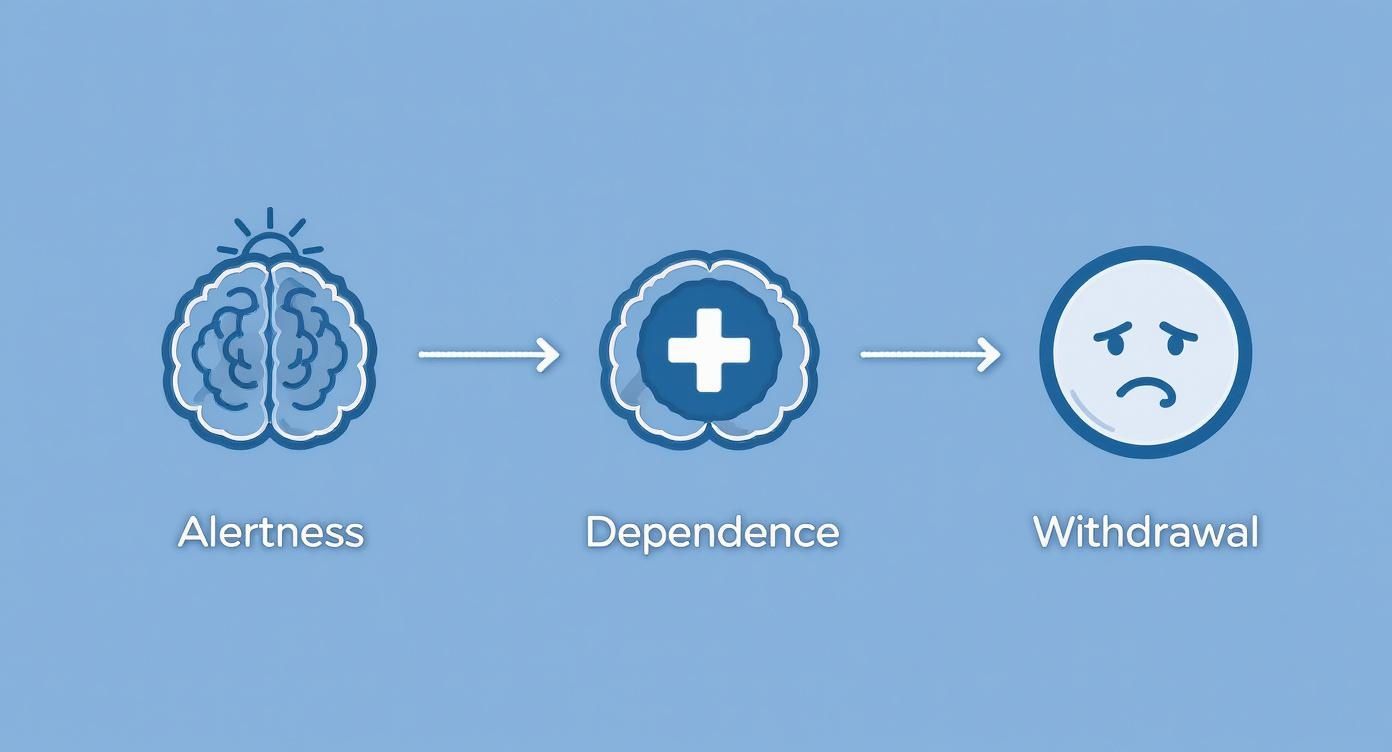how to avoid caffeine withdrawal symptoms: 7 practical steps

If you want to avoid the brutal side effects of caffeine withdrawal, the absolute best way to do it is to gradually reduce your intake over a few weeks. Quitting cold turkey is a recipe for disaster. This slow tapering process gives your brain time to adjust, minimizing the shock that triggers those infamous headaches, soul-crushing fatigue, and irritability.
A steady, planned reduction is your key to a much smoother, more comfortable transition off caffeine.
Why Caffeine Withdrawal Happens and How to Beat It
That pounding headache and overwhelming fog you feel after skipping your morning coffee? It's not just in your head—it's a very real, physical response from your brain. Before we get into the solutions, it helps to understand the "why" behind it. It all comes down to a brain chemical called adenosine.
Caffeine’s magic trick is blocking adenosine receptors. Adenosine is the neurotransmitter that signals your brain when it's time to slow down and feel tired. By getting in the way, caffeine keeps you feeling alert and wired. But your brain is smart. Over time, it adapts to this daily blockade by creating more adenosine receptors to try and maintain balance. This is how physical dependence starts.
The Science of the Crash
When you suddenly cut off the caffeine supply, your brain is left with a ton of extra, open adenosine receptors. All at once, the adenosine you’ve been holding back comes flooding in, latching onto these receptors and causing the classic symptoms of withdrawal. This sudden chemical shift is what triggers the headaches, brain fog, and that intense craving for another cup.
Understanding this mechanism is the first step toward a pain-free approach. You aren’t just fighting a bad habit; you’re letting your brain's chemistry recalibrate. A gradual taper gives your brain the time it needs to gently prune back those extra receptors.
This process is so well-documented that caffeine withdrawal is a clinically recognized condition. In fact, symptoms show up in about 50% of habitual users who stop or significantly reduce their intake, with the most common complaints being headaches, fatigue, and poor concentration. This happens because the abrupt change disrupts brain activity that has grown accustomed to a daily dose of caffeine.
Setting Yourself Up for Success
By recognizing the biological reasons for withdrawal, you can approach this whole process with more strategy and way less frustration. Instead of fighting your body, you can work with it.
The goal here is to make the transition as smooth as possible, avoiding the severe crashes and irritability that derail so many attempts to quit. It’s also smart to manage the side effects you might already be experiencing, like the jitters. For some practical advice on that, check out our guide on how to stop caffeine jitters.
The strategies that follow are all designed to support this gentle recalibration, helping you reclaim your natural energy without the nasty side effects.
Build Your Personal Caffeine Tapering Plan
Trying to quit caffeine "cold turkey" is a one-way ticket to a week of misery. Anyone who's tried it knows the headaches, brain fog, and irritability that follow. The real secret to ditching the dependency without the pain is a slow, methodical taper.
Forget rigid, one-size-fits-all plans. The most successful approach is one you design around your own habits.
First thing's first: you need a moment of brutal honesty. Figure out how much caffeine you're actually consuming every day. This isn't just about coffee. You have to count the tea, soda, energy drinks, pre-workout, and even that afternoon chocolate bar. Knowing your true daily number is the foundation of any good plan.
This infographic perfectly shows how that daily habit turns into a cycle of dependency, which is exactly why a gradual taper is so important.

As you can see, shocking your system by stopping suddenly is what triggers those awful withdrawal symptoms. We're going to reverse the process gently.
Choosing Your Tapering Method
Once you've calculated your daily total, it's time to pick a strategy that feels doable. The goal is to sidestep the worst of the headaches and fatigue by slowly reducing your intake. A good rule of thumb is to aim for a 25% reduction every few days or each week. This slow-and-steady approach gives your body time to adjust.
Here are a few proven methods you can adapt to your own routine:
- The 25% Weekly Drop: This is the most straightforward method. If you drink four cups of coffee a day, you'll drop to three for the first week. The next week, you go down to two. Simple.
- The Half-Caf Switch: Perfect for coffee lovers who enjoy the ritual. Start replacing half of your regular coffee grounds with decaf when you brew a pot. You get the taste and warmth without all the caffeine.
- Gradual Dilution: This works great for tea and soda drinkers. You can either brew your tea for a shorter amount of time each day or start mixing your caffeinated soda with a caffeine-free version, slowly tweaking the ratio over time.
Real-World Tapering Examples
Let's look at how this works in practice. A common daily intake is around 400 mg of caffeine, which is roughly four 8-ounce cups of coffee. Here are a couple of sample schedules to show you how to get from 400 mg to near-zero over two weeks.
Sample Caffeine Tapering Schedules
| Week/Day | Method 1 Daily Goal (25% Weekly Reduction) | Method 2 Daily Goal (Slower Daily Reduction) |
|---|---|---|
| Week 1 (Days 1-7) | 300 mg (e.g., three cups of coffee) |
Days 1-3: 350 mg Days 4-7: 300 mg |
| Week 2 (Days 8-14) | 200 mg (e.g., two cups of coffee) |
Days 8-10: 250 mg Days 11-14: 200 mg |
As you can see, Method 1 is a simple weekly drop, while Method 2 offers a more gradual, step-down approach for those who are more sensitive to caffeine changes. After two weeks, you'd continue this pattern until you're down to one cup, then half a cup, and eventually, just decaf or a caffeine-free alternative.
The most important thing here is to listen to your body. If a 25% reduction feels like too much, dial it back to 15% or 20%. This is your plan. The only rule is to make consistent, downward progress without making yourself miserable.
Finding good substitutes is a huge part of making this work. You need something to fill the void, especially when that 3 PM slump hits. To make it easier, we put together a guide with some excellent alternatives to caffeine for energy that will help you stay on track.
Find Your Perfect Caffeine-Free Ritual
Giving up caffeine doesn’t mean you have to abandon the comfort of a warm morning drink or that mid-afternoon pick-me-up. For many of us, the psychological pull of these routines is just as powerful as the caffeine itself.
The secret to success is simple: replace the caffeine, not the ritual. This is where smart swaps become your best allies in sidestepping those dreaded withdrawal symptoms.

Instead of dwelling on what you're losing, focus on what you can gain. This is your chance to explore a whole world of flavorful, functional alternatives that actually support your body instead of trapping it in a dependency cycle. From invigorating herbal teas to rich coffee substitutes, your new favorite ritual is out there waiting.
Smart Swaps for Your Daily Brew
Finding the right substitute is a personal journey, but the options are better than ever. You can tailor your swap to the time of day and the effect you’re after, whether that’s focus, relaxation, or just a comforting flavor.
Here are a few excellent places to start:
-
Herbal Teas for Every Mood: These are your most versatile tools. Peppermint tea is fantastic for boosting focus without any stimulants, while ginger tea can aid digestion and gives you a gentle, warming kick. In the evenings, chamomile or lavender is perfect for winding down and improving sleep quality—a game-changer for managing withdrawal fatigue.
-
Chicory Root Coffee: If you're really missing that deep, roasted flavor of coffee, chicory root is a must-try. It has a similar dark, nutty taste and brews just like your old go-to. Even better, chicory is a source of inulin, a prebiotic fiber that supports gut health.
-
High-Quality Decaf: Don't write off decaf just yet. A well-made decaffeinated coffee can deliver the same rich taste and comforting aroma you're used to, making it an ideal transition tool. It lets you keep the ritual intact while slashing your caffeine intake.
By replacing the substance but not the habit, you essentially trick your brain into feeling satisfied. The simple act of holding a warm mug can be enough to soothe a craving and keep you on track.
The Critical Role of Hydration
When you're trying to dodge caffeine withdrawal, proper hydration is non-negotiable. Dehydration is a huge trigger for headaches and will amplify feelings of fatigue, making your symptoms feel ten times worse.
Since caffeine is a mild diuretic, your body needs extra help staying balanced as it adjusts. Make it a point to drink plenty of water throughout the day.
If plain water feels like a chore, mix it up. Infusing water with lemon, cucumber, or berries makes it far more appealing. You can also set reminders on your phone or grab a marked water bottle to track your intake.
For those moments when you just need something to do—like during a long drive or a deep work session—you need an easy, on-the-go option. Exploring things like our caffeine-free gum and pouches can satisfy that oral fixation and provide a mental break without derailing your progress. You can find our complete collection of Focus Pouches and Focus Gum on our website.
How to Manage Headaches and Fatigue Naturally
Even with the most careful tapering plan, you're bound to hit a few bumps. The most common hurdles? That infamous caffeine headache and a lingering sense of fatigue or brain fog. Think of this section as your toolkit for tackling these symptoms head-on with natural strategies that support your body’s adjustment period.
The whole game is about managing these discomforts without caving and reaching for another cup of coffee.

Successfully navigating these challenges isn't about just "toughing it out." It’s about having the right relief strategies ready to go when you need them most. From simple physical remedies to mental exercises, you have plenty of effective, non-caffeinated options.
Natural Relief for Caffeine Headaches
That throbbing headache is, without a doubt, the most dreaded symptom. It happens because caffeine constricts the blood vessels in your brain. When you stop drinking it, they expand, causing a painful rush of blood flow. Fortunately, you can find real relief without popping a pill.
A few simple, physical techniques can work wonders:
- Apply a Cold Compress: Placing a cold pack or a cool, damp cloth on your forehead or the back of your neck can help numb the area and constrict those blood vessels, providing surprisingly fast relief.
- Gentle Temple Massage: Use your fingertips to apply steady, circular pressure to your temples for a minute or two. It’s a simple move that can release a surprising amount of tension and improve blood flow.
- Stay Hydrated: This one’s huge. Dehydration is a major headache trigger on its own, so sipping cold water throughout the day can prevent a bad situation from getting worse.
Fighting Fatigue and Brain Fog
Feeling exhausted and unfocused is just your brain’s way of telling you it’s recalibrating. Instead of fighting it with more stimulants, the best approach is to support your natural energy cycles with a few smart habits.
Getting a quick burst of natural sunlight can do wonders for your alertness and mood. A brisk five-to-ten minute walk outside exposes you to Vitamin D and helps reset your internal clock, shaking off that sluggish feeling.
Another powerful tool is the strategic power nap. The key is to keep it short—around 20 minutes is the sweet spot. This gives you a quick cognitive boost without letting you fall into a deep sleep that leaves you feeling even groggier. For those looking for extra support during this phase, our guide on the best supplements for mental clarity can help complement your efforts.
Managing Mood and Irritability
Caffeine withdrawal doesn’t just hit you physically; it can also make you feel irritable or stressed out. Research confirms that abruptly cutting back can cause psychological distress because your brain's neurotransmitter systems need time to find their balance again.
To keep stress and anxiety from taking over during your taper, mindfulness practices can be a game-changer.
Mindfulness isn't about forcing your mind to be empty. It's about observing your thoughts and feelings without judgment. Even five minutes of focused breathing can calm your nervous system and dial down that irritability.
If you want to take this a step further, consider exploring Mindfulness Based Stress Reduction (MBSR) techniques. These practices are specifically designed to help you build resilience against stress, making them an incredible resource as you navigate the toughest days of your caffeine transition.
Lifestyle Habits That Support Your Transition
Making it through the caffeine taper is one thing, but staying off it for good? That requires a bigger strategy. Lasting success comes from building a lifestyle that naturally fills the energy gaps caffeine used to patch over.
Think of it like this: you're not just getting rid of a habit, you're renovating your body's entire energy system. To do that, you need a solid foundation built on three pillars: smart nutrition, consistent movement, and deep, restorative sleep. Nailing these will make the transition smoother and set you up with sustained, natural energy.
Stabilize Your Energy with Smart Nutrition
When you’re cutting back on caffeine, blood sugar crashes feel ten times worse. That sudden dip in energy is often what sends people running right back to their coffee pot. The fix is surprisingly simple: eat meals that provide slow-release fuel.
Build your plate around a solid trio of protein, healthy fats, and complex carbs. For example, trade that sugary cereal for oatmeal loaded with nuts and berries. This combo keeps your blood sugar stable, preventing the dramatic energy dives that scream for a quick caffeine hit. For a smoother journey off caffeine, it helps to be adopting a holistic wellness approach that supports your entire system.
Boost Your Mood with Gentle Movement
Fighting off withdrawal fatigue can feel like wading through mud. But gentle exercise is one of the most powerful tools you have to fight back. I’m not talking about a punishing gym session—even a brisk 15-20 minute walk can completely change your outlook.
Movement gets your blood flowing, releases mood-boosting endorphins, and pushes more oxygen to your brain, which directly combats that sluggish feeling and brain fog. Activities like yoga and light stretching are also fantastic for easing the tension and irritability that often pop up. The goal here is to energize your body, not exhaust it.
Better sleep is your ultimate recovery tool. Prioritizing rest allows your brain to recalibrate its chemistry and your body to heal, dramatically reducing the severity of withdrawal symptoms like headaches and fatigue.
Master Your Sleep Hygiene for True Recovery
When you're quitting caffeine, quality sleep is absolutely non-negotiable. This is your body's prime time to repair and reset. Start by locking in a consistent sleep schedule—yes, even on weekends—to get your internal clock back on track.
Create a wind-down routine that signals to your body it’s time to rest. This could be reading a book, taking a warm bath, or meditating for just a few minutes. Most importantly, make your bedroom a screen-free zone for at least an hour before bed. The blue light from your phone is notorious for messing with melatonin, the hormone that tells your brain it's time to sleep.
These small adjustments will massively improve your sleep quality and provide the foundation you need for long-term energy and focus.
Common Questions About Ditching Caffeine
Deciding to go caffeine-free is a big step, and it’s natural to have questions. Knowing what’s coming and how to handle it can be the difference between a rough ride and a smooth transition.
Here are some clear, straight-to-the-point answers to the most common questions we get.
How Long Do Caffeine Withdrawal Symptoms Last?
This is usually the first thing people want to know. While it varies for everyone, there’s a general timeline you can expect. Symptoms typically kick in about 12 to 24 hours after your last cup.
They usually hit their peak intensity within the first 24 to 51 hours and can hang around for anywhere from two to nine days. Following the gradual tapering plan we laid out is the best way to soften the blow—it seriously reduces the intensity and duration of the whole process.
Is It Better to Quit Cold Turkey or Taper Off?
Just about every expert agrees: taper off gradually. Quitting cold turkey is a massive shock to your system, which is why it often triggers those brutal headaches, crushing fatigue, and serious irritability.
Tapering isn’t a sign of weakness; it’s the smart way to play it. This approach gives your brain chemistry time to adjust slowly, which dramatically boosts your chances of sticking with it and makes the whole thing a lot less miserable.
By slowly reducing your intake, you give your brain’s adenosine receptors a chance to reset without a major disruption. That's the real secret to avoiding the worst of the withdrawal symptoms.
Can I Use Decaf Coffee to Help Me Quit?
Absolutely. Using decaf is one of the best tricks in the book for tapering down. It lets you keep the ritual and taste you love while you methodically cut back on the actual caffeine.
Going "half-caf"—mixing regular coffee with decaf—is a super effective strategy. Just remember that most decaf isn't 100% caffeine-free. It usually has a tiny amount, around 2-15 mg per cup, which makes it the perfect tool for stepping down gradually.
When you need to stay sharp and energized without the jitters and crash from caffeine, Dialed In Nootropics offers a better way. Our Focus Pouches and Focus Gum are designed to support your brain's natural performance. They'll help you stay alert and productive while you make the switch—and long after.
Find your new go-to for clean, sustained mental clarity right here: https://focuspouches.com.

